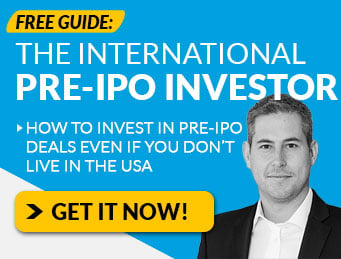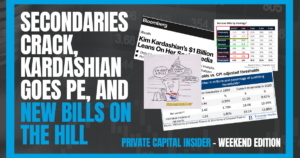You already know that Pre-IPO investing is high risk and speculative in nature…
But here’s the thing most everyday investors don’t understand about managing risk in their portfolio.
Investing is about aiming to minimize the risk required to generate wealth over the long term… not chasing after short-term profits.
To do this, we have to talk about what risk is… the types of risks in every deal… and how to strive to reduce those risks to an acceptable level.
The Two Types of Risk (and how to manage them properly)
First things first, let’s talk about what “risk” actually is: the permanent loss of capital.
Every single investment you make &alndash; even if that investment is in cash – there is some chance that you will “lose” money.
With this in mind, we – as investors – have to decide how much risk we are willing to take in order to achieve our financial goals (called your “risk profile”).
As an investor, the expectation is that the more risk you are taking, the higher the potential reward should be.
This dynamic is called the “risk adjusted return.” In practice, this means if two or more investments delivered the same return over a given time period, the one that has the lowest risk will have a better risk-adjusted return.
While it is true that no investment is fully free of all possible risks, certain securities have so little practical risk that they are considered risk-free or riskless.
These are things like certificates of deposits (CDs), government money market accounts, and U.S. Treasury bills.
When it comes to calculating your risk adjusted return, one of these “risk free” investments is used as the baseline.
Professional investors will often turn this into a number or a rating of some sort. Most commonly, they’ll use something called the “Sharpe Ratio.”
I’ll spare you the boring mathematical explanation of how this works. But here’s the important takeaway you should take from this…
Diversification should theoretically increase your Sharpe Ratio (which is good), and therefore your risk adjusted return.
But what risks are we looking to protect the portfolio from when selecting investments?
Generally speaking, there are two types of risks in every single investment opportunity: systematic risk and unsystematic risk.
Systematic risks – also known as market risks – are risks that can affect an entire economic market overall or a large percentage of the total market.
These are things like:
- Geopolitical risk – a change in government, legislative bodies, other foreign policy makers, or military control.
- Interest rate risk – an investment’s value will change due to a change in the absolute level of interest rates.
- Inflation risk – loss of purchasing power because the investments do not earn higher returns than inflation.
- Currency risk – losing money on foreign exchange investments because of movement in the exchange rates is currency risk.
- Liquidity risk – not able to sell the securities at a fair price and converting into cash.
- Country risk – a country won’t be able to honor its financial commitments (i.e. it defaults). This type of risk is most often seen in emerging markets or countries that have a severe deficit.
For those of you who’ve been following the news lately, you’ve already seen all of these things play out in real time.
Threats of higher inflation, rising interest rates, and the Ukraine/Russia conflict are causing all sorts of volatility in the stock markets…
And we’ve seen these systematic risk factors start to depress early stage valuations as well.
While these risks are certainly something to be concerned about, they are largely outside of our (or the companies we are investing in) control.
To manage these risks, investors will often add non-correlated assets – like gold, real estate, or art – that can potentially provide downside protection (or upside returns) when markets go sideways.
However, when it comes to investing into early stage companies, we find it more useful to focus more on unsystematic risk – also known as “business risk.”
These types of risks are things that only impact a specific industry or a particular company, like…
- Management Risk – Is management going to change? If so, how will that impact the business?
- IP/Product Risk – Does the product actually work? Can they defend their intellectual property and prevent copy cats?
- Demand Risk – Is there existing demand for the solution the company sells? And is demand increasing?
- Supply Chain Risk – Can they scale up supply to meet demand? Fast enough to beat competitors?
- Regulatory Risk – Can they legally sell it? Is there a regulatory approval process they must navigate and comply with?
- Competitive Risk – Can they compete against other well-funded competitors and incumbents?
- Legal Risk – What kind of legal exposure does the firm have today? In the future?
- Bad Actor Risk – Is this business actually a business? Or is it a scam pretending to be a business?
Eventually, the primary reason why investors lose money in early stage companies is that they run out of cash, go out of business, and/or are forced to sell at a loss.
Our goal is to understand where the real risks in the business are… what management plans to do to decrease these risks… and based on that information, decide if the valuation and deal terms make sense for our risk profile.
Final Thoughts
The biggest mistake inexperienced investors make is this: they analyze investments on a one-to-one basis.
They ask questions like, “Is XYZ a good investment?” Unfortunately, without the context of knowing your investment goals, what assets you currently own in your portfolio, and what other investments you have access to…
It’s basically impossible to answer that question.
As Warren Buffet famously said: “Risk comes from not knowing what you are doing.”
For this reason, the #1 way to reduce risk in your investment activity is to create an Investment Policy Statement.
This document is a requirement for all professional investors that outlines important questions like…
- How big is the portfolio you’re managing?
- What are your expected returns?
- What strategy will you use to generate those returns?
- What asset classes will you (and won’t you) consider?
- How many positions will you be managing?
- What is your risk profile?
- What are your liquidity requirements?
While financial planning isn’t the sexiest thing in the world, your investment activity should be relative to your personal financial needs… not to arbitrarily “beat the market” (or some other benchmark).
As always, if you don’t know how to answer these questions on your own, it’s never a bad idea to talk to a qualified financial advisor.
Sincerely,
Jake Hoffberg – Publisher
Equifund













